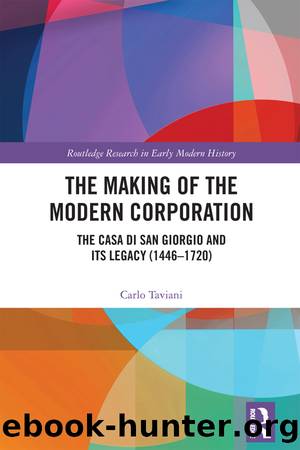The Making of the Modern Corporation by Carlo Taviani;

Author:Carlo Taviani; [Taviani;, Carlo]
Language: eng
Format: epub
ISBN: 9781032198927
Publisher: TaylorFrancis
Published: 2022-09-15T00:00:00+00:00
7.2. First Memorial Against San Giorgio
Two analyses originating from the circle of the Officium Monetae emphasized the duality of power in Genoa and offered a radical critique of San Giorgio in two secret memorials dating from the second half of the fifteenth century and addressed to the duke of Milan, Francesco Sforza, ruler of Genoa from 1464 (Appendices 1 and 2).15 I describe the two texts as the âfirstâ and âsecondâ only because the former contains more information than the latter. The second memorial may predate the first; it is undated and the signature, although visible, is illegible. Both are unofficial, informal documents written as suggestions for the duke of Milan. While we cannot be entirely sure that a member of the Officium Monetae penned the second memorial, the author probably knew the author of the first, as the texts are similar. The author of the first memorial, Giovanni Capello, was a notary and scribe of the Officium Monetae. He was not a prominent figure or a key player in Genoese finance or politics, and we know little about him. The few sources are from the Milanese and Genoese archives and include a financial document: the budget for the ordinary expenses of Genoa for 1462â63. Like other members of the chancellery of the Officium Monetae such as Paolo Cortese and Bartolomeo Soldano, Giovanni Capello had close ties to the Milanese governor, Sagramoro Visconti, and the Milanese offices.16 Administrative personnel such as Capello, especially those who worked in the financial offices, typically left few documents behind, although some, like Bartolomeo Senarega, chancellor of the Commune, and Antonio Gallo, chancellor of San Giorgio, not only drafted official acts but also wrote chronicles and histories of their city, then a widespread practice.17 Capello had a dual role as official of the Officium Monetae and advisor on Genoese matters to the duke. His relationship with the Sforza family in Milan probably predated the Milanese dominion over Genoa. In October 1462, Francesco Sforza, duke of Milan, signed a receipt of 200 gold ducats for Giovanni Capello, who had advanced the sum for an unspecified âsecret serviceâ (servitio secreto).18 The Milanese duke had already started to plan the occupation of Genoa, which he captured in 1464, and was probably already using Giovanni Capello as an advisor or agent. Capello also wrote the budget of the Commune of Genoa for 1462â63, which had a powerful impact on the Genoese economy: it cut expenses by an historically unprecedented 35%. In the previous year, the budget was set at â¤77,141.50, and its average in prior years ranged between â¤76,000 and â¤80,000. Capello slashed it to â¤50,000. Although Jacques Heers has defined it as a âmilitary budget,â one of the heaviest reductions was in military expenditures, from around 64.1% of the total in 1461 to 48.65% in 1462.19 The cuts focused on soldiers and territorial control. A galley that patrolled the coasts was decommissioned, for the meager resources available could now be used only to maintain a lembo, a smaller boat.
Download
This site does not store any files on its server. We only index and link to content provided by other sites. Please contact the content providers to delete copyright contents if any and email us, we'll remove relevant links or contents immediately.
Patriot by Alexei Navalny(315)
Museum of Antiquity by T. L. (Thomas Louis) Haines(265)
The Memoirs of Pere Labat, 1693-1705 by Jean Baptiste(225)
Richard III and the Princes in the Tower by A.J. Pollard(216)
The Story of Joan of Arc by Andrew Lang(197)
The Apollo Moon Missions by Randy Walsh(195)
2,2-Dimethyl-3,4-dihydro-2H-1,4-benzoxazines as isosteres of 2,2-dimethylchromans acting as inhibitors of insulin release and vascular smooth muscle relaxants by Bernard Pirotte & Xavier Florence & Eric Goffin & Philippe Lebrun(178)
Fry The Brain: The Art of Urban Sniping and its Role in Modern Guerrilla Warfare by John West(172)
A History of the Peninsular War, Vol. 5, Oct. 1811-Aug. 31, 1812 by Charles Oman(168)
1916 - The Battle of the Five Empires: 15 May - 28 September 1916 by Benoît Chenu(162)
Life of Napoleon Bonaparte, Volume I. by Walter Scott(162)
The Memoirs of Count Grammont â Complete by Hamilton Anthony Count Walter Scott(162)
Maleficium: Witchcraft and Witch Hunting in the West by Gordon Napier(158)
Famous Fights of Indian Native Regiments by Reginald Hodder(146)
Father Browne's Titanic Album by E. E. O'Donnell(139)
Rasputin the Rascal Monk by William Le Queux(134)
BY MARK Twain, Twain - The innocents at home by 1881(134)
The Thoughts of Marcus Aurelius by Marcus Aurelius(131)
Joanna of Flanders by Julie Sarpy(126)
